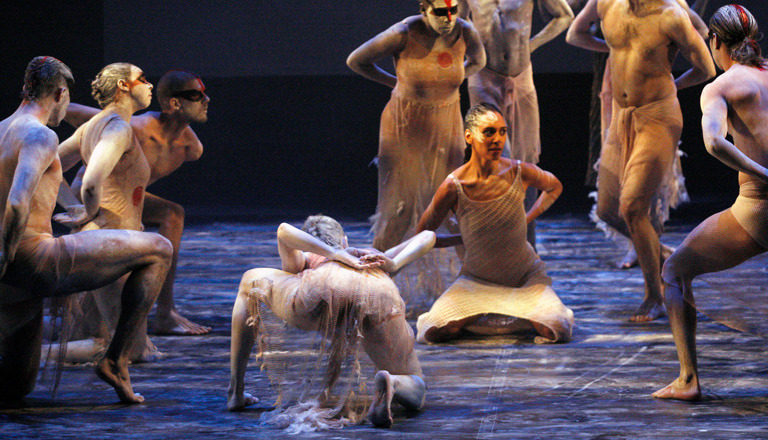Brolga (2001)
Before Viewing
Inspired by a brolga plain in Northeast Arnhem Land and stories told by Djakapurra Munyarryun, Brolga represents a contemporary rite of passage for a young woman who plays with the birds, mimics their movements and learns to respect their sacred knowledge.
THINGS TO THINK ABOUT - FOR YEARS 3/4
What do students already know and what are some things that they can do?
- Have the students experienced moving their body both individually and with others; showing awareness of their body in space and in relation to objects around them?
- Do they have an awareness of position and understand the difference between different parts of their body, moving in different directions, levels, shapes and pathways?
- Can they move with another person and explore moving around, side-by-side and in front and behind?
- Do the children understand that movements can be used to explore and improvise dance ideas for example gliding like a bird, jumping in the mud?
- Do they realise that it is possible to interpret meanings from watching dance and that when part of an audience it is important to concentrate on experiencing the dance by watching and listening?
Pose questions to expand their knowledge of the ideas the dance is based on.
- What kind of creature is a brolga?
- Can you find out its name in an Aboriginal or Torres Strait Islander language? What is the name and where is this language spoken?
- What does this bird look like?
- Have you ever seen a bird with long legs?
- Does this bird have a nest? What does the nest look like?
Pose questions that expand students’ knowledge about where and how Aboriginal and Torres Strait Island people live.
Bangarra is a company of Aboriginal and Torres Strait dancers based in Sydney. The dancers are from all different parts of Australia. Expand students understanding that contemporary Indigenous people participate in all facets of the community and as artists they may choose to communicate ideas on based on traditional stories including those relating to animals which represent spirits.
- Where do the brolga live?
- Where is Arnhem Land? Who does the land there belong to?
- Who are the dancers of Bangarra? Where do they come from?
THINGS TO THINK ABOUT - FOR YEARS 5/6
What do students already know and what are some things that they can do?
- Encourage the students to experience moving their body both individually and with others; showing awareness of their body in space and in relation to objects around them.
- Give them opportunities to develop an awareness of, and the ability to isolate different parts of their body and make specific actions and gestures.
- Include cross lateral movements in movement activities.
- Ask students to make contrasting shapes with their body (curved/angular; symmetrical/asymmetrical).
- Assist students understanding that movements can be used to explore and improvise dance ideas by controlling and combining different movement qualities.
- Give students opportunities to know that it is possible to show similarity and contrast through movement, for example, can they change the size and speed of their movement and follow pathways on the floor or in the air?
- Provide opportunities for students to practice controlling movement by pausing or freezing, and using contrasting qualities such as smooth and sustained, followed by percussive movement.
- Have students form groupings such as lines or group shapes and lead or follow others in these groupings, moving close together or far apart.
- Give them experiences which assist them to understand that movements can be joined together in order to move on the spot or travel in different ways.
- Check that students are aware that they can interpret meanings from watching dance and that dances can tell a story which may have a beginning, middle and end?
- Encourage students’ recognition that people from different cultures dance and may have different reasons for dancing.
- Assist students to understand that when part of an audience, it is important to concentrate on experiencing the dance by watching and listening.
Pose questions that help them understand the ideas that the dance is based on?
- What does a brolga look like and how does it move? What are its habits and rituals? (nesting, feeding, dancing, habitat)
- Where in Australia is this bird found?
- Why do some Aboriginal people use another word to describe this bird?
- Does this type of bird live anywhere near you?
- What are some of the ways it moves (on the ground and in the air).
Expand students’ understanding that contemporary Indigenous people participate in all facets of the community and as artists they may choose to communicate ideas on based on traditional stories including those relating to animals that represent spirits.
- Who are the Aboriginal people/s who live in Arnhem Land?
- Who are the dancers of Bangarra? Where do they come from?
- Where is the company Bangarra based?
- Who is Djakapurra Munyarryun?
Based on Australian Curriculum, Assessment and Reporting Authority (ACARA) Level 3 statements from the Critical and creative thinking learning continuum for generating ideas, possibilities and actions, Reflecting on thinking and processes and Analysing, synthesising and evaluating reasoning and procedures areas. Licensed under a Creative Commons Attribution-NonCommercial-ShareAlike 3.0 Australia (CC BY NC SA) licence. Accessed June 2013.

